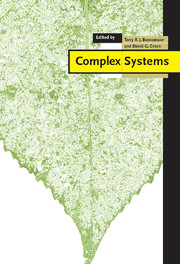Book contents
- Frontmatter
- Contents
- 1 Introduction
- 2 Self-organisation in complex systems
- 3 Network evolution and the emergence of structure
- 4 Artificial life: growing complex systems
- 5 Deterministic and random fractals
- 6 Non-linear dynamics
- 7 Non-linear control systems
- 8 Parallel computers and complex systems
- 9 Are ecosystems complex systems?
- 10 Complexity and neural networks
- Index
7 - Non-linear control systems
Published online by Cambridge University Press: 04 August 2010
- Frontmatter
- Contents
- 1 Introduction
- 2 Self-organisation in complex systems
- 3 Network evolution and the emergence of structure
- 4 Artificial life: growing complex systems
- 5 Deterministic and random fractals
- 6 Non-linear dynamics
- 7 Non-linear control systems
- 8 Parallel computers and complex systems
- 9 Are ecosystems complex systems?
- 10 Complexity and neural networks
- Index
Summary
Introduction
Control systems are prevelant in nature and in man-made systems. Natural regulation occurs in biological and chemical processes, and may serve to maintain the various constituents at their appropriate levels, for example. In the early days of the industrial revolution, governors were devised to regulate the speed of steam engines, while in modern times, computerised control systems have become commonplace in industrial plants, robot manipulators, aircraft and spacecraft, etc. Indeed, the highly maneuverable X-29 aircraft using forward swept wings is possible only because of its control systems, and moreover, control theory has been crucial in NASA's Apollo and Space Shuttle programmes. Control systems such as in these examples use in an essential way the idea of feedback, the central theme of this chapter.
Control theory is the branch of engineering/science concerned with the design and analysis of control systems. Linear control theory treats systems for which an underlying linear model is assumed, and is a relatively mature subject, complete with firm theoretical foundations and a wide range of powerful and applicable design methodologies (Anderson & Moore, 1990), (Kailath, 1980). In contrast, non-linear control theory deals with systems for which linear models are not adequate, and is relatively immature, especially in relation to applications. In fact, linear systems techniques are frequently employed in spite of the presence of non-linearities. Nonetheless, non-linear control theory is exciting and vitally important, and is the subject of a huge and varied range of research worldwide.
The aim of this chapter is to convey to readers of Complex Systems something of the flavour of the subject, the techniques, the computational issues, and some of the applications.
- Type
- Chapter
- Information
- Complex Systems , pp. 249 - 288Publisher: Cambridge University PressPrint publication year: 2000



